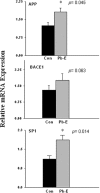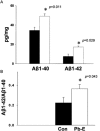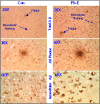Alzheimer's disease (AD)-like pathology in aged monkeys after infantile exposure to environmental metal lead (Pb): evidence for a developmental origin and environmental link for AD
- PMID: 18171917
- PMCID: PMC2486412
- DOI: 10.1523/JNEUROSCI.4405-07.2008
Alzheimer's disease (AD)-like pathology in aged monkeys after infantile exposure to environmental metal lead (Pb): evidence for a developmental origin and environmental link for AD
Abstract
The sporadic nature of Alzheimer's disease (AD) argues for an environmental link that may drive AD pathogenesis; however, the triggering factors and the period of their action are unknown. Recent studies in rodents have shown that exposure to lead (Pb) during brain development predetermined the expression and regulation of the amyloid precursor protein (APP) and its amyloidogenic beta-amyloid (Abeta) product in old age. Here, we report that the expression of AD-related genes [APP, BACE1 (beta-site APP cleaving enzyme 1)] as well as their transcriptional regulator (Sp1) were elevated in aged (23-year-old) monkeys exposed to Pb as infants. Furthermore, developmental exposure to Pb altered the levels, characteristics, and intracellular distribution of Abeta staining and amyloid plaques in the frontal association cortex. These latent effects were accompanied by a decrease in DNA methyltransferase activity and higher levels of oxidative damage to DNA, indicating that epigenetic imprinting in early life influenced the expression of AD-related genes and promoted DNA damage and pathogenesis. These data suggest that AD pathogenesis is influenced by early life exposures and argue for both an environmental trigger and a developmental origin of AD.
Figures






Similar articles
-
Tolfenamic acid downregulates BACE1 and protects against lead-induced upregulation of Alzheimer's disease related biomarkers.Neuropharmacology. 2014 Apr;79:596-602. doi: 10.1016/j.neuropharm.2014.01.009. Epub 2014 Jan 21. Neuropharmacology. 2014. PMID: 24462621 Free PMC article.
-
Infantile exposure to lead and late-age cognitive decline: relevance to AD.Alzheimers Dement. 2014 Mar;10(2):187-95. doi: 10.1016/j.jalz.2013.02.012. Epub 2013 Jul 15. Alzheimers Dement. 2014. PMID: 23867794 Free PMC article.
-
Environmental risk factors and the developmental basis for Alzheimer's disease.Rev Neurosci. 2005;16(4):325-37. doi: 10.1515/revneuro.2005.16.4.325. Rev Neurosci. 2005. PMID: 16519009 Review.
-
The fetal basis of amyloidogenesis: exposure to lead and latent overexpression of amyloid precursor protein and beta-amyloid in the aging brain.J Neurosci. 2005 Jan 26;25(4):823-9. doi: 10.1523/JNEUROSCI.4335-04.2005. J Neurosci. 2005. PMID: 15673661 Free PMC article.
-
Epigenetics, oxidative stress, and Alzheimer disease.Free Radic Biol Med. 2009 May 1;46(9):1241-9. doi: 10.1016/j.freeradbiomed.2009.02.006. Epub 2009 Feb 23. Free Radic Biol Med. 2009. PMID: 19245828 Free PMC article. Review.
Cited by
-
Histone acetylation: molecular mnemonics on the chromatin.Nat Rev Neurosci. 2013 Feb;14(2):97-111. doi: 10.1038/nrn3427. Epub 2013 Jan 17. Nat Rev Neurosci. 2013. PMID: 23324667 Review.
-
Reference values of hematology, biochemistry, and blood type in cynomolgus monkeys from cambodia origin.Lab Anim Res. 2016 Mar;32(1):46-55. doi: 10.5625/lar.2016.32.1.46. Epub 2016 Mar 24. Lab Anim Res. 2016. PMID: 27051442 Free PMC article.
-
Crossing the "Birth Border" for Epigenetic Effects.Biol Psychiatry. 2022 Aug 15;92(4):e21-e23. doi: 10.1016/j.biopsych.2021.10.025. Epub 2022 Mar 2. Biol Psychiatry. 2022. PMID: 35248366 Free PMC article. No abstract available.
-
Metal Toxicity Links to Alzheimer's Disease and Neuroinflammation.J Mol Biol. 2019 Apr 19;431(9):1843-1868. doi: 10.1016/j.jmb.2019.01.018. Epub 2019 Jan 18. J Mol Biol. 2019. PMID: 30664867 Free PMC article. Review.
-
Environmental Epigenetic Changes, as Risk Factors for the Development of Diseases in Children: A Systematic Review.Ann Glob Health. 2018 Jul 27;84(2):212-224. doi: 10.29024/aogh.909. Ann Glob Health. 2018. PMID: 30873799 Free PMC article.
References
-
- Abdolmaleky HM, Smith CL, Faraone SV, Shafa R, Stone W, Glatt SJ, Tsuang MT. Methylomics in psychiatry: modulation of gene-environment interactions may be through DNA methylation. Am J Med Genet B Neuropsychiatr Genet. 2004;127:51–59. - PubMed
-
- Abdolmaleky HM, Cheng KH, Russo A, Smith CL, Faraone SV, Wilcox M, Shafa R, Glatt SJ, Nguyen G, Ponte JF, Thiagalingam S, Tsuang MT. Hypermethylation of the reelin (RELN) promoter in the brain of schizophrenic patients: a preliminary report. Am J Med Genet B Neuropsychiatr Genet. 2005;134:60–66. - PubMed
-
- Ball MJ, Lo P. Granulovacuolar degeneration in the ageing brain and in dementia. J Neuropathol Exp Neurol. 1977;36:474–487. - PubMed
-
- Barker DJ, Winter PD, Osmond C, Margetts B, Simmonds SJ. Weight in infancy and death from ischaemic heart disease. Lancet. 1989;2:577–580. - PubMed
Publication types
MeSH terms
Substances
Grants and funding
- AG027246/AG/NIA NIH HHS/United States
- R01 AG018884/AG/NIA NIH HHS/United States
- R0AG18884/AG/NIA NIH HHS/United States
- Z01 ES021164/ImNIH/Intramural NIH HHS/United States
- ES013022/ES/NIEHS NIH HHS/United States
- R21 ES013022/ES/NIEHS NIH HHS/United States
- P20 RR016457/RR/NCRR NIH HHS/United States
- R0AG18379/AG/NIA NIH HHS/United States
- R15 AG023604/AG/NIA NIH HHS/United States
- R01 AG018379/AG/NIA NIH HHS/United States
- P20RR016457/RR/NCRR NIH HHS/United States
- R03 AG027246/AG/NIA NIH HHS/United States
- 1R15AG023604-01/AG/NIA NIH HHS/United States
LinkOut - more resources
Full Text Sources
Other Literature Sources
Medical
Molecular Biology Databases
